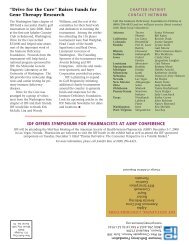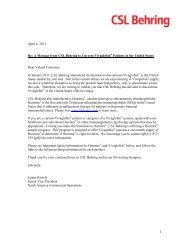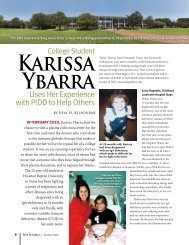IDF Patient & Family Handbook for Primary Immunodeficiency ... - IDFA
IDF Patient & Family Handbook for Primary Immunodeficiency ... - IDFA
IDF Patient & Family Handbook for Primary Immunodeficiency ... - IDFA
You also want an ePaper? Increase the reach of your titles
YUMPU automatically turns print PDFs into web optimized ePapers that Google loves.
80<br />
Laboratory Tests<br />
Laboratory Evaluation of the Immune System<br />
Laboratory studies are essential to evaluate the<br />
immune system to determine the presence of<br />
primary immunodeficiency disease. The laboratory<br />
evaluation of a person’s immune system is usually<br />
prompted by an individual experiencing some<br />
clinical problems such as a recurrent and/or<br />
chronic infection. In<strong>for</strong>mation regarding the types of<br />
organisms, the sites of infection and the therapies<br />
required to effectively treat the individual’s infection<br />
often help focus the laboratory studies. It is critical<br />
to recognize that it is the patient’s medical history<br />
and physical exam that direct the appropriate<br />
choice of laboratory tests.<br />
This chapter will focus on basic approaches<br />
in using the laboratory, limitations in using this<br />
data and a general concept of how to interpret<br />
laboratory data.<br />
Normal Versus Abnormal Laboratory Values<br />
An important aspect of interpreting any laboratory<br />
value, especially those relating to the immune<br />
system, is what values are considered normal<br />
and what values are considered abnormal. To<br />
determine what is “normal,” samples are obtained<br />
from a group of healthy individuals, who most<br />
often are adults and equally divided between<br />
males and females.<br />
Once the test is given to these “normal”<br />
individuals, the results can be used to determine<br />
what the “normal” range is <strong>for</strong> these tests using<br />
a variety of statistical approaches or tools. One<br />
of the more common statistical measurements<br />
is called a 95% confidence interval, which is a<br />
calculated range that includes 95% of the “normal”<br />
results. Other statistical approaches that can be<br />
used include calculating a mean and standard<br />
deviation <strong>for</strong> the results from the “normal”<br />
individuals. In all of these calculations, the tested<br />
“normal” group is viewed as representing the<br />
general “normal” population. The range generated<br />
from the “normal” group can be used to decide<br />
if a result from a patient is “normal” or “not<br />
normal.” It is important to note that by definition<br />
when the “normal range” is set to include a 95%<br />
confidence interval, 5% of the remaining samples<br />
from “normal” individuals are outside this (normal)<br />
range; 2.5% will have values above the range and<br />
2.5% will have values below the range.<br />
Using the measurement of height as an example,<br />
normal individuals can be just above or just below<br />
a normal range (or 95% confidence interval) and<br />
still be normal. Someone 1 inch taller than the<br />
95% confidence interval is not necessarily a giant<br />
and someone 1 inch shorter is not necessarily<br />
a dwarf. In fact, by definition, 2.5% of normal<br />
individuals will fall below the 95% confidence limit<br />
and 2.5% will fall above!<br />
The fact that 5% of otherwise normal healthy<br />
individuals will fall outside the normal range is<br />
important when looking at laboratory results—<br />
finding a value outside of the reference range<br />
does not automatically represent an abnormality.<br />
The clinical relevance of an “abnormal” laboratory<br />
finding must be based on the clinical history as well<br />
as the size of the difference from the normal range.<br />
Another important issue to consider <strong>for</strong> the proper<br />
interpretation of laboratory results is that the data<br />
must be compared to the appropriate normal<br />
group or reference range. This is a crucial issue <strong>for</strong><br />
tests of immune function related to age because<br />
the immune system undergoes substantial<br />
development during childhood. The range of test<br />
values that are “normal” in infancy will probably<br />
be quite different when the child is 2 or 20 years<br />
old. Consequently, all studies in children must be<br />
compared to age-related reference ranges. If the<br />
laboratory reporting test results does not provide<br />
age specific in<strong>for</strong>mation, it is important to consult<br />
with a specialist who can suggest appropriate<br />
age-specific reference ranges. Optimally, this<br />
should be provided by the laboratory per<strong>for</strong>ming<br />
the tests, but if these are not available, it is<br />
acceptable to interpret laboratory results using<br />
published age-specific reference ranges.<br />
The actual laboratory tests chosen should be based<br />
on clinical history and physical examination. The<br />
laboratory work-up can be broken up into approaches<br />
used to evaluate immune disorders characterized<br />
as antibody deficiencies, cellular (T-cell) defects,<br />
neutrophil disorders and complement deficiencies.<br />
These four major categories of tests <strong>for</strong> immune<br />
deficiencies are described below. In<strong>for</strong>mation about<br />
evaluative approaches, tests used to screen <strong>for</strong><br />
abnormalities and more sophisticated testing used<br />
to better characterize the disorder are included.
















